Thursday, November 30, 2006
American Dad Clos Du Bois
Add to My Profile | More Videos
Did Clos du Bois pay to get this PR or did it just happen... and would they want it?
Thanks to Craig Nichols for this.
Wednesday, November 29, 2006

Thanks to Gerry Williams for this from Radio Five this morning.
Some very sage advice on the pros and cons of blogging.
Tuesday, November 28, 2006
There seems to be a trend at the moment for brands to do search ads. Just thought it's interesting - especially as Absolut have done an interactive version.
Spot Stella's film references:
To see the answer click here.
Find all 74 bands alluded to here:
To see the answers to this one click here.
Find all the Absolut bottle: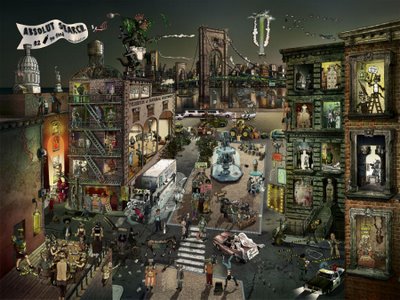
But I don't have the answers to the Absolut one so give it a go yourself here.
Happy searching.
LX TV is an online lifestyle TV channel specialising in food, drink, entertainment and fashion.
This screen grab below is from a video they host guiding viewers through the world of Scotch. To watch the video click here.
More interesting still is this video for Absolut Ruby Red.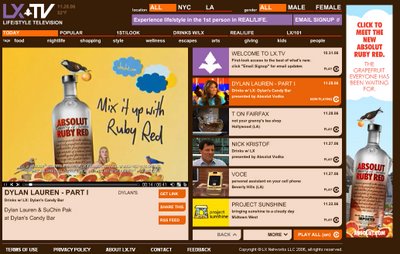
It is the first installment in a three part series linking the spirtit with cocktails, cool bars and exciting social occassions. Moreover it's supported by an ad on the right of the screen linking to Absolut's Ruby Red website. This is a great example of how to incorporate video material online whilst integrating it into the rest of the brand campaign.


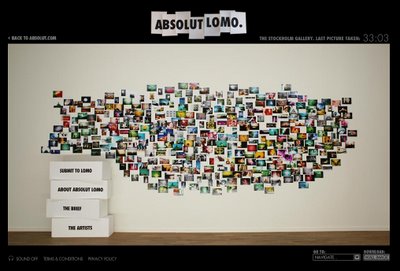
To enter the Absolut Lomo contest or to see what it's all about click here.
It all sounds a bit like Hype to me:
"Apart from simply visiting the Gallery and see the artwork, visitors to the ABSOLUT LOMO site will be given the opportunity to send in their own pictures. The photos will then be printed out – inside the Gallery – and fitted on the wall, thus becoming part of the exhibition.
If you don’t want to participate with your photos in the exhibition you are more than welcome as a spectator: Once visitors have ventured to the Gallery, they will be able to zoom in on all photographs on the wall and post comments on them. A rating system of the photographs is also available. During December, January and February, the rankings generated by visitors will be displayed on the site."
Monday, November 27, 2006
Tuesday, November 21, 2006

The latest website from 42 below vodka.http://www.42belowstories.com/Based on the award-winning creative - we can now go online and use the images provided to tell a story and of course forward it onto our friends.

Hugh MacLeod, the man driving Stormhoek wine’s recent marketing initiatives through his blog, Gapingvoid, has been thinking about ‘ooze’; a word he has used to abbreviate the term ‘Objects of Sociability’. ‘Ooze’, he writes, ‘is the future of marketing.’
What exactly does this mean? Put simply, Ooze is something that ‘allows you to engage with another person.’ Hugh predicts that in years to come, having something which gets people talking will be more important for brands than having a ‘Message’.
"What is an Object of Sociability [OoS, or "Ooze" for short]? "Ooze" is simply something that allows you to engage with another person. It could be anything. It could a party. It could be a bottle of wine. It could be a hyperlink. It could be a social gesture. It could be social currency. It could be doodling a cartoon on the back of a business card at a bar and giving it to the cute barmaid. You tell me."
This all chimes well for a company that is determined to pursue a course of making sure all its marketing promotes the idea of talkability. Any widget is a good widget. We want as many things to enter the social lexicon as possible and touch people's lives in a powerful way.
Thanks to Ellie for this.

I've been meaning to post this for a while. It's Mazda's "Global Brand Essence Site" which I think is fascinating. They've been very brave to open this out to the public but in doing so makes the brand far more accessible to the all the people working on the brand around the world. Far from giving the brand's strategic secrets away to competitors it makes Mazda seem confident in their marketing direction and must surely help to generate seemless global creative - even if their strapline does just say "Zoom Zoom"!
To see the site and view the video click here.
The concept of having a Global Brand Essence site, be it public or private is a very powerful idea.

"As if customized interiors and personalized number plates aren't enough, a company is now offering Porsche 911 owners "an extra personal touch", where they will replace the product type at the back with your choice of customized text. Let your creativity run wild and give your Porsche its own identity and a unique name. You can make up anything you want: 'made in Germany', 'back off', 'follow me' or 'have a nice day'... Or why not use the back of your Porsche to make a personal message like: 'no more Ferrari', 'my tird', or 'thanks daddy'."
Visit Name Your Porsche to give it a go if you happen to have a Porsche!
Friday, November 17, 2006
George Carlin describes the Modern Man using the buzz words of the day.
Thursday, November 16, 2006
Thanks to Ellie Grant for this post:
Chris Anderson, Wired magazine’s editor-in-chief, recently published a book which is causing quite a stir.
The Long Tail: The New Economics of Culture and Commerce forecasts the demise of the hits-driven culture which defined the twentieth century, predicting instead that the emerging digital economy of the twenty-first century will herald a new entertainments industry relying just as much on ‘misses’, niche markets and mass-customisation.
See this video here for the launch party for the book in conjunction with Wired and Flavourpil.
Anderson argues that the twentieth century saw an entertainments industry physically constrained by the economics of supply-and-demand. Retailers would only carry content which they knew would generate demand sufficient enough to cover costs. Roughly translated, this meant that your local HMV would only have ordered as many copies of an album as they believed would sell within your local area. As a result, the twentieth century saw the ‘tyranny of the hit’ and a society of people who watched the same films, listened to the same music and read the same books. Anderson anticipates that as the entertainments industry moves into the digital world, the individual will become the focus as opposed to the mass market. Online retailers have the capacity to supply products that are in low demand or have low sales volume, though which collectively make up a market share that rivals or exceeds the relatively few current bestsellers and blockbusters. Companies such as Amazon, NetFlix, iTunes and Rhapsody are at the forefront of this emerging trend, catering to individual preferences and tastes.
These are his three rules for ‘The New Entertainment Economy’:
1. “Make Everything Available”: offer anything and everything online on the off-chance that it will find a buyer. For the film industry, this could mean offering up previously underserved genres, such as Bollywood films, documentaries, foreign films, and independent flicks.
2. “Cut the price in half. Now lower it”: iTunes singles currently retail at $0.99 (79p in the UK). While the labels argue this price is too low, and fear that lowering prices further will drive consumers away from record stores, potentially leading to a massive CD retailer rebellion, consumers would often argue that $0.99 is too high when they could just use a peer-to-peer network to get their tracks for free. Anderson argues that if online retailers lowered their prices, consumers would actually buy more, meaning the industry wouldn’t suffer as much damage as it currently believes it would. He suggests that the entertainments industry as a whole could entice consumers down the Long Tail by lowering prices.
3. “Help me find it”: Online retailers need initially to attract consumers with hits and then guide them down the Long Tail using the ‘Other customers have bought…/Other users recommend…’ format, just as Amazon and iTunes do at the moment. You might therefore begin by buying Britney Spears’ Greatest Hits. A recommendation would encourage you to listen to Pink, which might lead you to No Doubt, which might lead on to some obscure 1980s Southern Californian punk outfit. A Britney fan will have been guided down the Long Tail and in the process discovered they have tastes which diverge radically from the mainstream.
If the entertainments industry follows Anderson’s advice, the future will see the provision of entertainment in abundance, endless choice supplied by digital and online retailers and opportunities for the consumer to discover something which he might never have found by wandering into town on a Saturday afternoon.
The author recently gave a talk about his book and hosted a book signing in Second Life with the help of Millions of Us . See what he had to say by watching the video.
Anderson’s book has got the Beam Team thinking about how the Long Tail theory might be applied to our booze brands. There are the obvious constraints relating to the physical distribution of alcohol; we can’t sell alcohol online in the same way Amazon shifts CDs, books and DVDs or in the same way iTunes allows us to download music. However, we can learn an important lesson from The Long Tail: If you create a supply, you might just find you have a demand.
We might find there are opportunities to draw consumers’ attention to these little-known brands and create a few ‘Global Microbrands’ in the process, especially if we consider that in the future, consumers might become used to always being offered such a wise choice in other areas of their lives. We could start guiding them down the Long Tail, attempting to broaden their tastes beyond the ‘hit’ global mega-brands.
For the economic and statistical theory of the Long Tail, and more basic facts, hit the Wikipedia page.
Have a look on Squidoo for more info.
Buy the book.
For a PDF of the Long Tail click here and be patient.
If anyone's got any thoughts or comments feel free to share. Thank you Ellie for this.
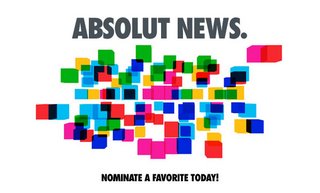
From Yes but no but Yes:
"Nike and Burger King get a lot of kudos for having innovative online offerings, but for my money, one of the most interesting sites created in support of a brand is Absolut.com. Over the years they've created many thought provoking pieces based around the arts, and are always updating and refreshing. Check out the latest piece to go live - The 100 Absolutes - where you can nominate your favorite - well, anything really. It's not a new concept, but I love the way that it's been implemented."
It's a great website, tremendous idea, looks awesome and also serves as a research project.
The site was created by Great Works from Sweden who have also built sites for Absolut Bling Bling and created the internal marketing material for Ruby Red.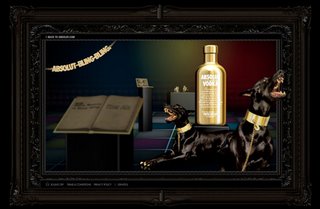

Wednesday, November 15, 2006
Marketing, Advertising, PR & Branding Explained
0 comments Posted by Paul Crowe at 11/15/2006 07:14:00 pmTuesday, November 14, 2006
"This clip was from Late Night with David Letterman 10 years ago. Roughly 9 years later, Fallon shot a nice ad for Sony. Makes you wonder." Anita O'Shea
To see the Sony ad that this resembles click see below.
Comments on YouTube so far include: 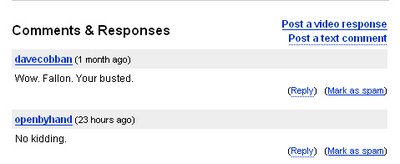
See the previous post on Sony Bravia and Tango. I think's its amusing how Sony were happy for Tango to rip their ad off and now they seem to have nicked it from Letterman in the first place. It all reminds me of the Bacardi Salmon ad that appropriated an urban meme. I wonder what will happen!
Thursday, November 09, 2006
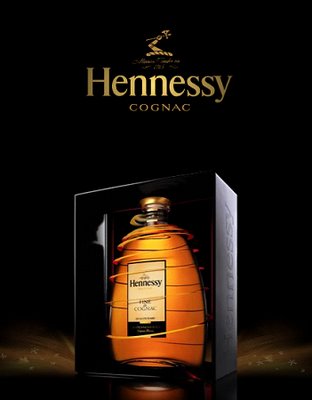
Hennessy's new Christmas VSOP Fine de Cognac giftpack in the UK looks very stylish. They have collaborated with Central St Martin's Design College to create this much in the same spirit of last year's design by artist, Nadya Bertaux, below.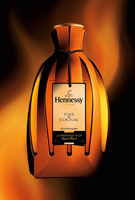
This design competition was hosted on Dexigner.com where you can find this rationale for the design:
"For the holiday season, the artist Nadya Bertaux and Hennessy have joined forces to give the Hennessy Fine de Cognac bottle a completely new gift box. Nadya’s work on the box takes its inspiration from a combination of her own work and the development process of the cognac.
Through her creation Nadya Bertaux evokes the mysterious evaporation of the eaux de vie during the cognac production cycle, which has the poetic name "the angels’ share ". This gift box symbolises this mysterious phenomenon, and the series of strips that she makes allow us a glimpse of the warm, amber colours of the cognac."

From PSFK
"To combat the local movie bootleg market (which continues to improve in quality and sophistication), films in China and Hong Kong are being released in legal DVD formats simultaneously with theatrical screenings. The price premium of an authorized DVD has been reduced as well in an attempt to lure buyers into "trading up."
An original copy now costs around RMB 13 compared to a RMB 9 counterfeit. To offset the reduction in premium, the new DVDs are front-loaded with advertising. For instance, Motorola put an ad for their new Moto Krzr phone in The Banquet DVD.
Perhaps a modified product placement rate structure for DVDs/online video will also be considered in the future?"
It's interesting to see Remy making use of sly, innovative media. In addition their increasing use of the Centuar is noteworthy. It's a good example of making the most out of the East meets West dynamic.
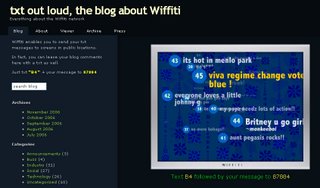
From Textually.org...
"Text Messaging is now moving from the private sphere into the public one reports The Economist via Chicagoist. "New technologies allow text messages to be displayed on the sides of buildings, on public screens in cafés or on vast digital displays at sporting events and festivals.
Such “digital graffiti” can be used in various ways: to capture the mood of a gathering, boost a brand, or to spark public dialogue.
... The earliest examples of digital graffiti appeared in Europe, where text messaging took off years ago, unlike in America where it has only recently become popular. In 2001, for example, at the Speaker's Corner building in Huddersfield, England, a tickertape-like display showed the results of a text-message poetry contest.
The latest digital-graffiti systems are rather more elaborate. ... Wiffiti allows a passerby to text a message to be displayed on a screen, a wall, television...
Eight “Wiffiti” screens (a name derived from “wireless graffiti”—it has no relation to Wi-Fi networking) have been set up in coffee-shops in American cities, sometimes with the support of sponsors."
The implications for our brands are interesting. A branded screen in a student union would be a great form of physical social networking. Or it could be made more upscale by locating it in a style bar.
Thanks to Sunita for this, I've got a feeling this will develop fast.








